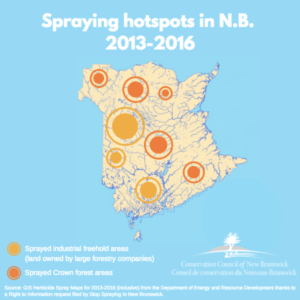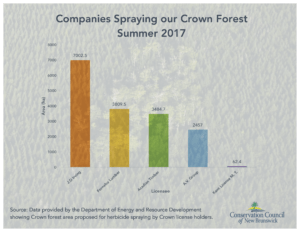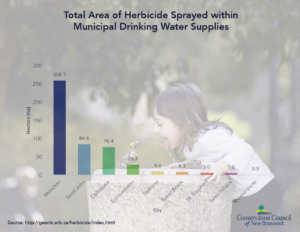NB Power and the Canadian National Railway Company (CN) have released details of their respective herbicide spraying programs for summer 2018.
In a notice printed in the New Brunswick Telegraph-Journal on Wednesday, June 20, CN says it will use herbicide to clear vegetation along railway tracks beginning July 4 through Aug. 31.
Tracks in several New Brunswick communities are slated to be sprayed, including Moncton, Saint John, Dalhousie, Saint-Leonard, Grand Falls, Hampton, Rothesay, Quispamsis, Sussex, Norton, Memramcook, Bathurst, Edmundston, and more. Check here to see if your community is on the list.
NB Power posted its 2018 herbicide spray map on its website earlier this month. The public utility says it received provincial approval to spray herbicides Navius, Clearview Brush and Vision Max on approximately 1,500 hectares of transmission right of ways. The spraying is expected to begin in early June and continue through mid-August.
Areas slated for spraying include transmission right of ways from St. Andre to Edmundston, Nackawic to McAdam, Norton to Salisbury, Miramichi to Bathurst, Bathurst to Caraquet, Bathurst to Belledune, Eel River to Tide Head, and Keswick to Salisbury. See the full list here.
Forestry companies up next
Roughly 13,000 hectares of Crown forest are sprayed with herbicides by large forestry companies each year in New Brunswick in order to kill hardwoods and other plants that compete with seedlings.
At a cost of roughly $1,000 per hectare, New Brunswick’s auditor general determined that herbicide spraying, which is taxpayer-funded, contributes to the province’s annual forest deficit.
The provincial government traditionally posts maps in late July showing where companies will spray during the coming season. The last couple of years the information has been posted to an interactive map hosted by forestinfo.ca, a partnership between government and the forestry industry.
Your Conservation Council will monitor the site closely and bring you details of where the Crown forest will be sprayed near you — including near popular lakes, rivers and within municipal drinking water supply areas — when the map becomes available.
Check out the links below to see our maps from the 2017 spraying season.
What’s the problem with spraying herbicides?
The forest industry sprays clearcut areas with herbicides to kill hardwoods and vegetation that compete with the spruce, fir and pine companies grow in plantations.
The Conservation Council has long advocated that the province stop the old-fashioned, taxpayer-funded practice of spraying the forest. Quebec banned the spraying of its public forest more than 15 years ago and Nova Scotia stopped using taxpayers’ money to spray its forest. Glyphosate, the main active ingredient in most herbicides used in Crown forest operations in New Brunswick, has been listed as a probable carcinogen by the World Health Organization in 2015. Click here to learn more about glyphosate and its health impacts on people and wildlife.
Conservationists, biologists and hunters are worried that spraying vegetation is wiping out the food and habitats of our forest wildlife.
Last summer and fall, more than 1,800 New Brunswickers wrote their MLA to call for an end to herbicides in our forest.
Let’s take the herbicides out of the woods and put more people to work in 21st century forestry and silviculture practices that conserve and restore a healthy, resilient and diverse forest!
Be part of our forest conservation efforts. Donate $50, $15, $5 or more to help fund our work. Stay tuned for our second annual 5 Days for the Forest festival coming up in September. Donate today!
Recommended links:
- Where our forest is being sprayed this summer
- Herbicide spraying within municipal drinking water supply areas
- 2017 spraying hotspots near New Brunswick lakes
- Read the debate over the motion on glyphosate spraying in NB
- New Brunswick’s ongoing fight against glyphosate spraying on Crown forests
- Taking glyphosate out of forest is prudent move: Glynn
- Glynn urges new forest management model after federal report shows significant changes coming with climate change
- Canada’s pesticide regulator “captured by industry”
- AG report shows DNR ignored calls to reduce clearcutting in public forest




